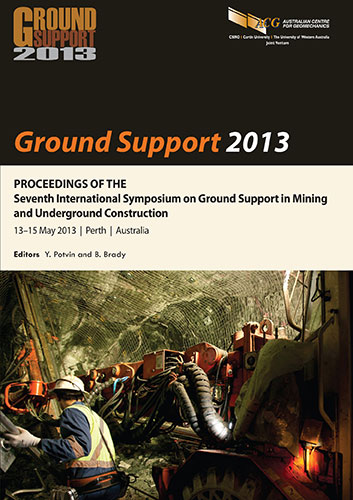Dynamic testing of Tekseal high yield grout to provide an orepass plug designed for impact

|
Authors: Mutton, IVS; Remennikov, AM; Pateman, D Paper is not available for download Contact Us |
DOI https://doi.org/10.36487/ACG_rep/1304_17_Mutton
Cite As:
Mutton, IVS, Remennikov, AM & Pateman, D 2013, 'Dynamic testing of Tekseal high yield grout to provide an orepass plug designed for impact', in Y Potvin & B Brady (eds), Ground Support 2013: Proceedings of the Seventh International Symposium on Ground Support in Mining and Underground Construction, Australian Centre for Geomechanics, Perth, pp. 265-283, https://doi.org/10.36487/ACG_rep/1304_17_Mutton
Abstract:
Significant wear in orepasses particularly in the brow and chute areas is proportional to the tonnage throughput with increased wear associated with running orepasses empty. During planned shutdowns it may be necessary to isolate maintenance crews from objects falling from orepasses. In the last 15 years grout orepass plugs that can later be easily removed have been poured above chute maintenance areas. These provide protection from high energy impact and isolating workers from the hazard. Construction and removal methods will be briefly explained. Since it is not feasible to investigate the problem of orepass plug impact response using full-scale experimental studies, this paper presents a combined three-stage approach that includes: To calibrate numerical models, three 1 m diameter steel pipes filled with Tekseal high yield foaming grout were tested with falling steel projectiles of different shape using the High-Capacity Impact Testing Facility at the University of Wollongong. Impact tests provided data on the depth of penetration and size of the craters formed by the projectiles. Numerical models were calibrated by optimising the material parameters and modelling techniques to match with the experimental results. Full-scale numerical models of orepass plugs were developed for typical orepass dimensions and subjected to impact events by falling rock projectiles. The proposed approach has allowed investigating energy absorbing characteristics of orepass plugs to further predict and increase understanding of their capacity to withstand high-speed impacts by large falling projectiles. This research will enable better understanding of orepass plug performance during high energy events and provide further engineering definition to mitigate risk to orepass maintenance personnel.
References:
Carr, C.J. and Krause, L.E. (2005) Ore Pass and Chute Maintenance at Xstrata Copper-Mount Isa Copper Operations, Ninth Underground Operators’ Conference 2005, Perth, Australia, 7–9 March 2005, AusIMM, Carlton, pp. 235–243.
Evans, W.M. (1972) The spalling of armour plate and the influence of backing liners, Ministry of Defence, Royal Armament Research and Development Establishment, November 1972, UK.
Hadjigeorgiou, J., Lessard, J.F. and Mercier-Langevin, F. (2005) Ore pass practice in Canadian mines, The Journal of The South African Institute of Mining and Metallurgy, December 2005, pp. 813–814.
LS-DYNA (2008) LS-DYNA Nonlinear Dynamic Analysis of Structures User's Manual, Version 971, Livermore Software Technology Corp., Livermore, USA.
MINOVA (2008) 120 psi MAIN LINE TEKSEAL® MSHA Approval Number: 120M-02.0, Posted Construction Guidelines, p. 10.
Reipas, K. (1996) Rehabilitation of an underground ore storage bin at Myra Falls, International Journal of Rock Mechanics and Mining Sciences and Geomechanics, Vol. 33, No. 5, July 1996, pp. 234A–234A(1).
© Copyright 2025, Australian Centre for Geomechanics (ACG), The University of Western Australia. All rights reserved.
View copyright/legal information
Please direct any queries or error reports to repository-acg@uwa.edu.au
View copyright/legal information
Please direct any queries or error reports to repository-acg@uwa.edu.au